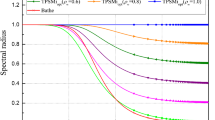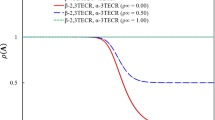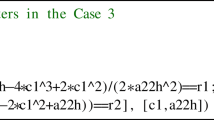Abstract
In this paper, a novel implicit family of composite two sub-step algorithms with controllable dissipations is developed to effectively solve nonlinear structural dynamic problems. The primary superiority of the present method over other existing integration methods lies that it is truly self-starting and so the computation of initial acceleration vector is avoided, but the second-order accurate acceleration responses can be provided. Besides, the present method also achieves other desired numerical characteristics, such as the second-order accuracy of three primary variables, unconditional stability and no overshoots. Particularly, the novel method achieves adjustable numerical dissipations in the low and high frequency by controlling its two algorithmic parameters (\( \gamma \) and \( \rho _{\infty }\)). The classical dissipative parameter \( \rho _{\infty }\) determines numerical dissipations in the high-frequency while \( \gamma \) adjusts numerical dissipations in the low-frequency. Linear and nonlinear numerical examples are given to show the superiority of the novel method over existing integration methods with respect to accuracy and overshoot.



































Similar content being viewed by others
References
Hughes, T.J.R.: The Finite Element Method: Linear Static and Dynamic Finite Element Analysis. Dover Publications, Dover Civil and Mechanical Engineering, Dover (2000)
Bathe, K.J.: Finite Element Procedures, 2nd edn. Prentice-Hall, Englewood Cliffs (2014)
Butcher, J.C.: The Numerical Analysis of Ordinary Differential Equations: Runge–Kutta and General Linear Methods. John Wiley and Sons, New Jersey (1987)
Newmark, N.M.: A method of computation for structural dynamics. J. Eng. Mech. Div. 85(3), 67–94 (1959)
Wilson, E.L., Farhoomand, I., Bathe, K.J.: Nonlinear dynamic analysis of complex structures. Earthq. Eng. Struct. Dyn. 1(3), 241–252 (1972)
Park, K.C.: An improved stiffly stable method for direct integration of nonlinear structural dynamic equations. J. Appl. Mech. 42(2), 464–470 (1975)
Har, J., Tamma, K.K.: Advances in Computational Dynamics of Particles, Materials and Structures. Wiley, New York (2012)
Shao, H., Cai, C.: A three parameters algorithm for numerical integration of structural dynamic equations. Chin. J. Appl. Mech. 5(4), 76–81 (1988)
Chung, J., Hulbert, G.M.: A time integration algorithm for structural dynamics with improved numerical dissipation: the generalized-\(\alpha \) method. J. Appl. Mech. 60(2), 371–375 (1993)
Dokainish, M.A., Subbaraj, K.: A survey of direct time-integration methods in computational structural dynamics-I. explicit methods. Comput. Struct. 32(6), 1371–1386 (1989)
Subbaraj, K., Dokainish, M.A.: A survey of direct time-integration methods in computational structural dynamics-II. implicit methods. Comput. Struct. 32(6), 1387–1401 (1989)
de Borst, R., Crisfield, M.A., et al.: Non-Linear Finite Element Analysis of Solids and Structures. Wiley Series in Computational Mechanics. Wiley, New York (2012)
Wood, W., Bossak, M., Zienkiewicz, O.: An alpha modification of Newmark’s method. Int. J. Numer. Methods Eng. 15(10), 1562–1566 (1980)
Hilber, H.M., Hughes, T.J.R., Taylor, R.L.: Improved numerical dissipation for time integration algorithms in structural dynamics. Earthq. Eng. Struct. Dyn. 5(3), 283–292 (1977)
Shimada, M., Masuri, S., Tamma, K.K.: A novel design of an isochronous integration [iIntegration] framework for first/second order multidisciplinary transient systems. Int. J. Numer. Methods Eng. 102(3–4), 867–891 (2015)
Hulbert, G.M., Hughes, T.J.R.: An error analysis of truncated starting conditions in step-by-step time integration: consequences for structural dynamics. Earthq. Eng. Struct. Dyn. 15(7), 901–910 (1987)
Shimada, M., Hoitink, A., Tamma, K.K.: The fundamentals underlying the computations of acceleration for general dynamic applications: issues and noteworthy perspectives. CMES Comput. Model. Eng. Sci. 104(2), 133–158 (2015)
Benítez, J.M., Montáns, F.J.: The value of numerical amplification matrices in time integration methods. Comput. Struct. 128(5), 243–250 (2013)
Namburu, R.R., Tamma, K.K.: A generalized \(\gamma _s\)-family of self-starting algorithms for computational structural dynamics. In: AIAA Journal (1992)
Soares Jr., D.: A simple and effective new family of time marching procedures for dynamics. Comput. Methods Appl. Mech. Eng. 283, 1138–1166 (2014)
Soares, D.: An implicit family of time marching procedures with adaptive dissipation control. Appl. Math. Modell. 40(4), 3325–3341 (2016)
Soares Jr., D.: A simple and effective single-step time marching technique based on adaptive time integrators. Int. J. Numer. Methods Eng. 109, 1344–1368 (2016)
Soares Jr., D.: A model/solution-adaptive explicit-implicit time marching technique for wave propagation analysis. Int. J. Numer. Methods Eng. 119, 590–617 (2019)
Bathe, K.J., Baig, M.M.I.: On a composite implicit time integration procedure for nonlinear dynamics. Comput. Struct. 83(31–32), 2513–2524 (2005)
Bathe, K.J.: Conserving energy and momentum in nonlinear dynamics: A simple implicit time integration scheme. Computers & Structures 85(7–8), 437–445 (2007)
Li, J., Yu, K.: An alternative to the Bathe algorithm. Appl. Math. Modell. 69, 255–272 (2019)
Dong, S.: BDF-like methods for nonlinear dynamic analysis. J. Comput. Phys. 229(8), 3019–3045 (2010)
Li, J., Yu, K.: A novel family of composite sub-step algorithms with desired numerical dissipations for structural dynamics. Arch. Appl. Mech. 90, 737–772 (2019)
Malakiyeh, M.M., Shojaee, S., Bathe, K.J.: The Bathe time integration method revisited for prescribing desired numerical dissipation. Comput. Struct. 212, 289–298 (2019)
Noh, G., Bathe, K.J.: The Bathe time integration method with controllable spectral radius: the \(\rho _\infty \)-Bathe method. Comput. Struct. 212, 299–310 (2019)
Li, J., Li, X., Yu, K.: Enhanced studies on the composite sub-step algorithm for structural dynamics: the Bathe-like algorithm. Appl. Math. Modell. 80, 33–64 (2020)
Noh, G., Ham, S., Bathe, K.J.: Performance of an implicit time integration scheme in the analysis of wave propagations. Comput. Struct. 123, 93–105 (2013)
Li, J., Yu, K., Li, X.: A novel family of controllably dissipative composite integration algorithms for structural dynamic analysis. Nonlinear Dyn. 96(4), 2475–2507 (2019)
Chang, S.Y.: Dissipative, noniterative integration algorithms with unconditional stability for mildly nonlinear structural dynamic problems. Nonlinear Dyn. 79(2), 1625–1649 (2015)
Hilber, H.M., Hughes, T.J.R.: Collocation, dissipation and ‘overshoot’ for time integration schemes in structural dynamics. Earthq. Eng. Struct. Dyn. 6(1), 99–117 (1978)
Zhou, X., Tamma, K.K.: Design, analysis, and synthesis of generalized single step single solve and optimal algorithms for structural dynamics. Int. J. Numer. Methods Eng. 59(5), 597–668 (2004)
Li, J., Yu, K.: Noniterative integration algorithms with controllable numerical dissipations for structural dynamics. Int. J. Comput. Methods 15(3), 1850111 (2018)
Zhang, H.M., Xing, Y.F.: Optimization of a class of composite method for structural dynamics. Comput. Struct. 202, 60–73 (2018)
Noh, G., Bathe, K.J.: For direct time integrations: a comparison of the Newmark and \(\rho _\infty \)-Bathe schemes. Comput. Struct. 225, 106079 (2019)
Li, J., Yu, K., He, H.: A second-order accurate three sub-step composite algorithm for structural dynamics. Appl. Math. Modell. 77, 1391–1412 (2020)
Wood, W.L., Oduor, M.E.: Stability properties of some algorithms for the solution of nonlinear dynamic vibration equations. Commun. Appl. Numer. Methods 4(2), 205–212 (1988)
Nickell, R.: Nonlinear dynamics by mode superposition. Comput. Methods Appl. Mech. Eng. 7(1), 107–129 (1976)
Fernandes, W.L., Vasconcellos, D.B., Greco, M.: Dynamic instability in shallow arches under transversal forces and plane frames with semirigid connections. Math. Probl. Eng. 2018, 1–14 (2018). https://doi.org/10.1155/2018/1985907
He, H., Tang, H., Yu, K., Li, J., Yang, N., Zhang, X.: Nonlinear aeroelastic analysis of the folding fin with freeplay under thermal environment. Chin. J. Aeronaut. 33(9), 2357–2371 (2020)
Chung, J., Lee, J.M.: A new family of explicit time integration methods for linear and non-linear structural dynamics. Int. J. Numer. Methods Eng. 37(23), 3961–3976 (1994)
Acknowledgements
This work is supported by the National Natural Science Foundation of China (Grant No. 11372084). The helpful and constructive comments by the referees have led to the improvements of this paper; the authors gratefully acknowledge this assistance.
Author information
Authors and Affiliations
Corresponding author
Ethics declarations
Conflict of interest
The authors declare that there is no conflict of interests regarding the publication of this manuscript.
Additional information
Publisher's Note
Springer Nature remains neutral with regard to jurisdictional claims in published maps and institutional affiliations.
Rights and permissions
About this article
Cite this article
Li, J., Yu, K. A truly self-starting implicit family of integration algorithms with dissipation control for nonlinear dynamics. Nonlinear Dyn 102, 2503–2530 (2020). https://doi.org/10.1007/s11071-020-06101-8
Received:
Accepted:
Published:
Issue Date:
DOI: https://doi.org/10.1007/s11071-020-06101-8




